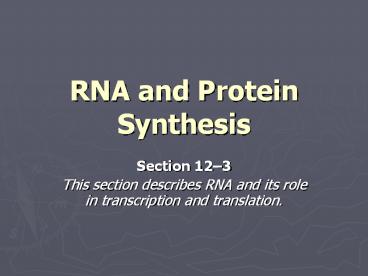RNA and Protein Synthesis - PowerPoint PPT Presentation
Title:
RNA and Protein Synthesis
Description:
RNA and Protein Synthesis Section 12 3 This section describes RNA and its role in transcription and translation. The Structure of RNA List the three main ... – PowerPoint PPT presentation
Number of Views:45
Avg rating:3.0/5.0
Title: RNA and Protein Synthesis
1
RNA and Protein Synthesis
- Section 123
- This section describes RNA and its role in
transcription and translation.
2
The Structure of RNA
- List the three main differences between RNA and
DNA. - RNA has ribose sugar instead of deoxyribose.
- RNA is generally single-stranded, instead of
double-stranded. - RNA contains uracil in place of thymine.
3
Purpose of RNA
- Is the following sentence true or false?
- RNA is like a disposable copy of a DNA segment.
- True
4
- What is the importance of the cells ability to
copy a single DNA sequence into RNA? - It makes it possible for a single gene to produce
large numbers of RNA molecules.
5
Types of RNA
- What is the one job in which most RNA
molecules are involved? - Most are involved inprotein synthesis.
6
Types of RNA
- Complete the compare-and-contrast table about the
types of RNA.
7
Type Function
- Carries copies of the instructions for assembling
amino acids from DNA to the rest of the cell. - Ribosomal RNA is a part of ribosomes.
- Transfer RNA Transfers each amino acid to the
ribosome to help assembleproteins
8
Transcription
- Circle the letter of each sentence that is true
about transcription. - b. RNA polymerase uses one strand of DNA as a
template to assemble nucleotides intoa strand of
RNA. - c. RNA polymerase binds only to DNA promoters,
which have specific base sequences.
9
RNA Editing
- Many RNA molecules from eukaryotic genes have
sections, called _____, edited out of them before
they become functional. The remaining pieces,
called, _________are spliced together. - Introns
- Exons
10
RNA Editing
- Is the following sentence true or false?
- RNA editing occurs in the cytoplasm of the
cell. - False
11
RNA Editing
- What are two explanations for why some RNA
molecules are cut and spliced? - It makes it possible for a single gene to produce
several different forms of RNA. - It may play a role in evolution, making it
possible for small changes in DNA to have
dramatic effects in gene expression.
12
The Genetic Code
- Proteins are made by joining ________into long
chains called polypeptides. - Amino acids
13
The Genetic Code
- How can only four bases in RNA carry instructions
for 20 different amino acids? - The genetic code is read three letters at a time,
so that each word of the coded message is three
bases long.
14
The Genetic Code
- What is a codon?
- It consists of three consecutive nucleotides that
specify a single amino acid that is to be added
to a polypeptide.
15
The Genetic Code
- Circle the letter of the number of possible
three-base codons. - 4
- 12
- c. 64
- d. 128
16
The Genetic Code
- Is the following sentence true or false?
- All amino acids are specified by only one codon.
- False
17
The Genetic Code
- Circle the letter of the codon that serves as the
start codon for protein synthesis. - a.UGA
- b.UAA
- c. UAG
- d. AUG
18
Translation
- What occurs during the process of translation?
- The cell uses information from messenger RNA to
produce proteins.
19
Where does translation take place?
- Translation takes place on the ribosomes.
20
Circle the letter of each sentence that is true
about translation.
- Before translation occurs, messenger RNA is
transcribed from DNA in the nucleus. - It is the job of transfer RNA to bring the
proper amino acid into the ribosome to be
attached to the growing peptide chain. - When the ribosome reaches a stop codon, it
releases the newly formed polypeptide and the
mRNA molecule.
21
What is an anticodon?
- The three bases on a tRNA molecule that are
complementary to one of the mRNA codons.
22
The Roles of RNA and DNA
- Match the roles with the molecules.
- Roles
- Master plan - DNA
- Goes to the ribosomes in the cytoplasm - RNA
- Blueprint RNA
- Remains in the nucleus - DNA
23
Genes and Proteins
- Many proteins are_____, which catalyze and
regulate chemical reactions. - Enzymes
24
Is the following sentence true or false?
- Genes are the keys to almost everything that
living cells do. - false
25
Translation Four Major Steps
- A. Messenger RNA is transcribed in the nucleus
then enters the cytoplasm and attaches to an
ribosome. - B. Transfer RNA translation begins at AUG, the
start codon. Each anti-codon of tRNA complements
a codon of mRNA and binds a specific amino acid.
26
Translation Four Major Steps cont.
- C. The polypeptide assembly line as the codons
bind amino acids the ribosome joins them together
forming long chains of amino acids. - D. Completing the Polypeptide the process
continues until one of three stop codons is
reached.































